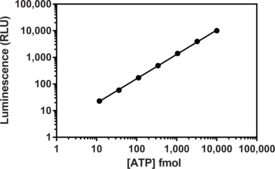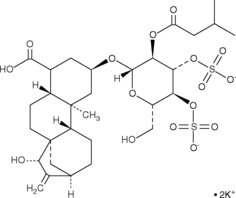Cayman
Showing 10651–10800 of 45550 results
-
ATHPINACA isomer 1 (Item No. 18365) is an analytical reference standard that is structurally categorized as a synthetic cannabinoid. The physiological and toxicological properties of this compound are not known. This product is intended for research and forensic applications.
Brand:CaymanSKU:-Available on backorder
Atipamezole is an imidazole that potently antagonizes the α2-adrenoceptor (Ki = 1.6 nM).{25705,25706} It shows selectivity over the α1-adrenoceptor (Ki = 13,300 nM) and is a poor antagonist at a wide variety of other receptors and channels.{25706} Through its effects at the α2-adrenoceptor, atipamezole reverses the sedative and analgesic effects of α2-adrenoceptor agonists, alters cognitive functions and sexual behavior, and has neuroprotective effects.{25706} It may also potentiate the effects of dopaminergic drugs used in Parkinson’s disease.{25704,25706}
Brand:CaymanSKU:9001181 - 10 mgAvailable on backorder
Atipamezole is an imidazole that potently antagonizes the α2-adrenoceptor (Ki = 1.6 nM).{25705,25706} It shows selectivity over the α1-adrenoceptor (Ki = 13,300 nM) and is a poor antagonist at a wide variety of other receptors and channels.{25706} Through its effects at the α2-adrenoceptor, atipamezole reverses the sedative and analgesic effects of α2-adrenoceptor agonists, alters cognitive functions and sexual behavior, and has neuroprotective effects.{25706} It may also potentiate the effects of dopaminergic drugs used in Parkinson’s disease.{25704,25706}
Brand:CaymanSKU:9001181 - 25 mgAvailable on backorder
Atipamezole is an imidazole that potently antagonizes the α2-adrenoceptor (Ki = 1.6 nM).{25705,25706} It shows selectivity over the α1-adrenoceptor (Ki = 13,300 nM) and is a poor antagonist at a wide variety of other receptors and channels.{25706} Through its effects at the α2-adrenoceptor, atipamezole reverses the sedative and analgesic effects of α2-adrenoceptor agonists, alters cognitive functions and sexual behavior, and has neuroprotective effects.{25706} It may also potentiate the effects of dopaminergic drugs used in Parkinson’s disease.{25704,25706}
Brand:CaymanSKU:9001181 - 5 mgAvailable on backorder
Atipamezole is an imidazole that potently antagonizes the α2-adrenoceptor (Ki = 1.6 nM).{25705,25706} It shows selectivity over the α1-adrenoceptor (Ki = 13,300 nM) and is a poor antagonist at a wide variety of other receptors and channels.{25706} Through its effects at the α2-adrenoceptor, atipamezole reverses the sedative and analgesic effects of α2-adrenoceptor agonists, alters cognitive functions and sexual behavior, and has neuroprotective effects.{25706} It may also potentiate the effects of dopaminergic drugs used in Parkinson’s disease.{25704,25706}
Brand:CaymanSKU:9001181 - 50 mgAvailable on backorder
The acetylation of opium with acetic anhydride, which converts morphine to heroin, produces a variety of other acetylated products from other endogenous alkaloids, including thebaine. ATM4 4-acetoxy analog is a major product of the acetylation of thebaine using acetic anhydride.{25328} It is the precursor of the acetylated thebaine metabolite ATM4, which is generated during phase I metabolism of ATM4 4-acetoxy analog by human liver microsomes.{25328} The physiological and toxicological properties of this compound are not known. This product is intended for forensic and research purposes.
Brand:CaymanSKU:-The acetylation of opium with acetic anhydride, which converts morphine to heroin, produces a variety of other acetylated products from other endogenous alkaloids, including thebaine. ATM4 4-acetoxy analog is a major product of the acetylation of thebaine using acetic anhydride.{25328} It is the precursor of the acetylated thebaine metabolite ATM4, which is generated during phase I metabolism of ATM4 4-acetoxy analog by human liver microsomes.{25328} The physiological and toxicological properties of this compound are not known. This product is intended for forensic and research purposes.
Brand:CaymanSKU:-The acetylation of opium with acetic anhydride, which converts morphine to heroin, produces a variety of other acetylated products from other endogenous alkaloids, including thebaine. ATM4 4-acetoxy analog is a major product of the acetylation of thebaine using acetic anhydride.{25328} It is the precursor of the acetylated thebaine metabolite ATM4, which is generated during phase I metabolism of ATM4 4-acetoxy analog by human liver microsomes.{25328} The physiological and toxicological properties of this compound are not known. This product is intended for forensic and research purposes.
Brand:CaymanSKU:-ATN-224 is a choline salt of tetrathiomolybdate and an inhibitor of superoxide dismutase 1 (SOD1; IC50s = 2.91 and 3.51 µM in human and mouse blood cells, respectively, in vitro).{36253} ATN-224 reduces the viability of cultured oxidative stress-resistant WEHI7.2 murine thymic lymphoma cells (EC50s = 5-6 nM) and human diffuse large B cell lymphoma cell lines (EC50s = 9.73-105.61 nM) independently of Bcl-2 and Bcl-xL.{36254,36255} In vivo, ATN-224 (0.7 mg/kg) chelates copper to stabilize an antitumor viral vector, enhancing its efficacy against lung metastases in mice.{36256} It also inhibits angiogenesis in a mouse model (IC50s = 1.50-3 mg/kg via gavage).{36253}
Brand:CaymanSKU:23553 - 1 mgAvailable on backorder
ATN-224 is a choline salt of tetrathiomolybdate and an inhibitor of superoxide dismutase 1 (SOD1; IC50s = 2.91 and 3.51 µM in human and mouse blood cells, respectively, in vitro).{36253} ATN-224 reduces the viability of cultured oxidative stress-resistant WEHI7.2 murine thymic lymphoma cells (EC50s = 5-6 nM) and human diffuse large B cell lymphoma cell lines (EC50s = 9.73-105.61 nM) independently of Bcl-2 and Bcl-xL.{36254,36255} In vivo, ATN-224 (0.7 mg/kg) chelates copper to stabilize an antitumor viral vector, enhancing its efficacy against lung metastases in mice.{36256} It also inhibits angiogenesis in a mouse model (IC50s = 1.50-3 mg/kg via gavage).{36253}
Brand:CaymanSKU:23553 - 10 mgAvailable on backorder
ATN-224 is a choline salt of tetrathiomolybdate and an inhibitor of superoxide dismutase 1 (SOD1; IC50s = 2.91 and 3.51 µM in human and mouse blood cells, respectively, in vitro).{36253} ATN-224 reduces the viability of cultured oxidative stress-resistant WEHI7.2 murine thymic lymphoma cells (EC50s = 5-6 nM) and human diffuse large B cell lymphoma cell lines (EC50s = 9.73-105.61 nM) independently of Bcl-2 and Bcl-xL.{36254,36255} In vivo, ATN-224 (0.7 mg/kg) chelates copper to stabilize an antitumor viral vector, enhancing its efficacy against lung metastases in mice.{36256} It also inhibits angiogenesis in a mouse model (IC50s = 1.50-3 mg/kg via gavage).{36253}
Brand:CaymanSKU:23553 - 5 mgAvailable on backorder
Atomoxetine is a selective norepinephrine reuptake inhibitor with Ki values of 5, 77, and 1,451 nM for norepinephrine, serotonin, and dopamine transporters, respectively.{38422} It is selective over the choline, GABA, and adenosine transporters, and a number of neurotransmitter receptors, ion channels, second messengers, and brain/gut peptides. In the rat prefrontal cortex (PFC), it increases extracellular norepinephrine and dopamine by 3-fold and increases Fos expression. Atomoxetine (0.1, 0.5, and 1 mg/kg) reduces premature responding, a measure of impulsivity, by rats in the 5-choice serial reaction time test (5CSRTT) in a dose-dependent manner.{38421} It also has neuroprotective effects when administered prior to ischemic damage in a gerbil model of transient cerebral ischemia.{38423} Formulations containing atomoxetine have been used in the treatment of attention-deficit hyperactivity disorder (ADHD) in children, adolescents, and adults.
Brand:CaymanSKU:22248 -Out of stock
Atomoxetine is a selective norepinephrine reuptake inhibitor with Ki values of 5, 77, and 1,451 nM for norepinephrine, serotonin, and dopamine transporters, respectively.{38422} It is selective over the choline, GABA, and adenosine transporters, and a number of neurotransmitter receptors, ion channels, second messengers, and brain/gut peptides. In the rat prefrontal cortex (PFC), it increases extracellular norepinephrine and dopamine by 3-fold and increases Fos expression. Atomoxetine (0.1, 0.5, and 1 mg/kg) reduces premature responding, a measure of impulsivity, by rats in the 5-choice serial reaction time test (5CSRTT) in a dose-dependent manner.{38421} It also has neuroprotective effects when administered prior to ischemic damage in a gerbil model of transient cerebral ischemia.{38423} Formulations containing atomoxetine have been used in the treatment of attention-deficit hyperactivity disorder (ADHD) in children, adolescents, and adults.
Brand:CaymanSKU:22248 -Out of stock
Atomoxetine is a selective norepinephrine reuptake inhibitor with Ki values of 5, 77, and 1,451 nM for norepinephrine, serotonin, and dopamine transporters, respectively.{38422} It is selective over the choline, GABA, and adenosine transporters, and a number of neurotransmitter receptors, ion channels, second messengers, and brain/gut peptides. In the rat prefrontal cortex (PFC), it increases extracellular norepinephrine and dopamine by 3-fold and increases Fos expression. Atomoxetine (0.1, 0.5, and 1 mg/kg) reduces premature responding, a measure of impulsivity, by rats in the 5-choice serial reaction time test (5CSRTT) in a dose-dependent manner.{38421} It also has neuroprotective effects when administered prior to ischemic damage in a gerbil model of transient cerebral ischemia.{38423} Formulations containing atomoxetine have been used in the treatment of attention-deficit hyperactivity disorder (ADHD) in children, adolescents, and adults.
Brand:CaymanSKU:22248 -Out of stock
Atomoxetine is a selective norepinephrine reuptake inhibitor with Ki values of 5, 77, and 1,451 nM for norepinephrine, serotonin, and dopamine transporters, respectively.{38422} It is selective over the choline, GABA, and adenosine transporters, and a number of neurotransmitter receptors, ion channels, second messengers, and brain/gut peptides. In the rat prefrontal cortex (PFC), it increases extracellular norepinephrine and dopamine by 3-fold and increases Fos expression. Atomoxetine (0.1, 0.5, and 1 mg/kg) reduces premature responding, a measure of impulsivity, by rats in the 5-choice serial reaction time test (5CSRTT) in a dose-dependent manner.{38421} It also has neuroprotective effects when administered prior to ischemic damage in a gerbil model of transient cerebral ischemia.{38423} Formulations containing atomoxetine have been used in the treatment of attention-deficit hyperactivity disorder (ADHD) in children, adolescents, and adults.
Brand:CaymanSKU:22248 -Out of stock
Atomoxetine-d3 is intended for use as an internal standard for the quantification of atomoxetine (Item No. 22248) by GC- or LC-MS. Atomoxetine is a selective norepinephrine reuptake inhibitor with Ki values of 5, 77, and 1,451 nM for norepinephrine, serotonin, and dopamine transporters, respectively.{38422} It is selective over the choline, GABA, and adenosine transporters, and a number of neurotransmitter receptors, ion channels, second messengers, and brain/gut peptides. In the rat prefrontal cortex (PFC), it increases extracellular norepinephrine and dopamine by 3-fold and increases Fos expression. Atomoxetine (0.1, 0.5, and 1 mg/kg) reduces premature responding, a measure of impulsivity, by rats in the 5-choice serial reaction time test (5CRTT) in a dose-dependent manner.{38421} It also has neuroprotective effects when administered prior to ischemic damage in a gerbil model of transient cerebral ischemia.{38423} Formulations containing atomoxetine have been used in the treatment of attention-deficit hyperactivity disorder (ADHD) in children, adolescents, and adults.
Brand:CaymanSKU:28162 - 1 mgAvailable on backorder
Atorvastatin is an inhibitor of HMG-CoA reductase, the rate-limiting enzyme in the mevalonate pathway of cholesterol synthesis, that has IC50 values of 73, 102, and 0.6 nM for HepG2 cells, human fibroblasts, and rat hepatocytes, respectively.{37553} Formulations containing atorvastatin have been used in the treatment of hypercholesterolemia and certain dyslipidemias.
Brand:CaymanSKU:10493 - 10 mgAvailable on backorder
Atorvastatin is an inhibitor of HMG-CoA reductase, the rate-limiting enzyme in the mevalonate pathway of cholesterol synthesis, that has IC50 values of 73, 102, and 0.6 nM for HepG2 cells, human fibroblasts, and rat hepatocytes, respectively.{37553} Formulations containing atorvastatin have been used in the treatment of hypercholesterolemia and certain dyslipidemias.
Brand:CaymanSKU:10493 - 25 mgAvailable on backorder
Atorvastatin is an inhibitor of HMG-CoA reductase, the rate-limiting enzyme in the mevalonate pathway of cholesterol synthesis, that has IC50 values of 73, 102, and 0.6 nM for HepG2 cells, human fibroblasts, and rat hepatocytes, respectively.{37553} Formulations containing atorvastatin have been used in the treatment of hypercholesterolemia and certain dyslipidemias.
Brand:CaymanSKU:10493 - 5 mgAvailable on backorder
Atorvastatin is an inhibitor of HMG-CoA reductase, the rate-limiting enzyme in the mevalonate pathway of cholesterol synthesis, that has IC50 values of 73, 102, and 0.6 nM for HepG2 cells, human fibroblasts, and rat hepatocytes, respectively.{37553} Formulations containing atorvastatin have been used in the treatment of hypercholesterolemia and certain dyslipidemias.
Brand:CaymanSKU:10493 - 50 mgAvailable on backorder
Atorvastatin lactone is a prodrug form of atorvastatin (Item No. 10493), an HMG-CoA reductase inhibitor used to lower blood cholesterol levels.{32968} The lactone hydrolyzes rapidly to the acid form of atorvastatin in human serum at room temperature.{32969} Atorvastatin lactone can also be formed in vivo from atorvastatin by certain uridine 5’-diphospho-glucuronosyltransferases.{32970} Like atorvastatin, the lactone inhibits P-glycoprotein in a concentration-dependent manner.{32967}
Brand:CaymanSKU:20951 -Out of stock
Atorvastatin lactone is a prodrug form of atorvastatin (Item No. 10493), an HMG-CoA reductase inhibitor used to lower blood cholesterol levels.{32968} The lactone hydrolyzes rapidly to the acid form of atorvastatin in human serum at room temperature.{32969} Atorvastatin lactone can also be formed in vivo from atorvastatin by certain uridine 5’-diphospho-glucuronosyltransferases.{32970} Like atorvastatin, the lactone inhibits P-glycoprotein in a concentration-dependent manner.{32967}
Brand:CaymanSKU:20951 -Out of stock
Atorvastatin lactone is a prodrug form of atorvastatin (Item No. 10493), an HMG-CoA reductase inhibitor used to lower blood cholesterol levels.{32968} The lactone hydrolyzes rapidly to the acid form of atorvastatin in human serum at room temperature.{32969} Atorvastatin lactone can also be formed in vivo from atorvastatin by certain uridine 5’-diphospho-glucuronosyltransferases.{32970} Like atorvastatin, the lactone inhibits P-glycoprotein in a concentration-dependent manner.{32967}
Brand:CaymanSKU:20951 -Out of stock
Atorvastatin lactone is a prodrug form of atorvastatin (Item No. 10493), an HMG-CoA reductase inhibitor used to lower blood cholesterol levels.{32968} The lactone hydrolyzes rapidly to the acid form of atorvastatin in human serum at room temperature.{32969} Atorvastatin lactone can also be formed in vivo from atorvastatin by certain uridine 5’-diphospho-glucuronosyltransferases.{32970} Like atorvastatin, the lactone inhibits P-glycoprotein in a concentration-dependent manner.{32967}
Brand:CaymanSKU:20951 -Out of stock
Atorvastatin-d5 is intended for use as an internal standard for the quantification of atorvastatin (Item No. 10493) by GC- or LC-MS. Atorvastatin is an inhibitor of HMG-CoA reductase, the rate-limiting enzyme in the mevalonate pathway of cholesterol synthesis, that has IC50 values of 73, 102, and 0.6 nM for HepG2 cells, human fibroblasts, and rat hepatocytes, respectively.{37553} Formulations containing atorvastatin have been used in the treatment of hypercholesterolemia and certain dyslipidemias.
Brand:CaymanSKU:25043 - 1 mgAvailable on backorder
Atorvastatin-d5 is intended for use as an internal standard for the quantification of atorvastatin (Item No. 10493) by GC- or LC-MS. Atorvastatin is an inhibitor of HMG-CoA reductase, the rate-limiting enzyme in the mevalonate pathway of cholesterol synthesis, that has IC50 values of 73, 102, and 0.6 nM for HepG2 cells, human fibroblasts, and rat hepatocytes, respectively.{37553} Formulations containing atorvastatin have been used in the treatment of hypercholesterolemia and certain dyslipidemias.
Brand:CaymanSKU:25043 - 500 µgAvailable on backorder
Atosiban is a peptide analog of oxytocin (Item No. 11799) that antagonizes the human oxytocin receptor (Ki = 81 nM).{33007} It also binds the vasopressin V1a receptor (Ki = 3.5 nM).{33007} Because of its effects on the oxytocin receptor, atosiban has tocolytic actions in the acute phase of imminent preterm birth.{33008,33009,33010}
Brand:CaymanSKU:20952 -Out of stock
Atosiban is a peptide analog of oxytocin (Item No. 11799) that antagonizes the human oxytocin receptor (Ki = 81 nM).{33007} It also binds the vasopressin V1a receptor (Ki = 3.5 nM).{33007} Because of its effects on the oxytocin receptor, atosiban has tocolytic actions in the acute phase of imminent preterm birth.{33008,33009,33010}
Brand:CaymanSKU:20952 -Out of stock
Atosiban is a peptide analog of oxytocin (Item No. 11799) that antagonizes the human oxytocin receptor (Ki = 81 nM).{33007} It also binds the vasopressin V1a receptor (Ki = 3.5 nM).{33007} Because of its effects on the oxytocin receptor, atosiban has tocolytic actions in the acute phase of imminent preterm birth.{33008,33009,33010}
Brand:CaymanSKU:20952 -Out of stock
Atosiban is a peptide analog of oxytocin (Item No. 11799) that antagonizes the human oxytocin receptor (Ki = 81 nM).{33007} It also binds the vasopressin V1a receptor (Ki = 3.5 nM).{33007} Because of its effects on the oxytocin receptor, atosiban has tocolytic actions in the acute phase of imminent preterm birth.{33008,33009,33010}
Brand:CaymanSKU:20952 -Out of stock
Atovaquone is a broad-spectrum antiprotozoal agent that is active against Plasmodium, Toxoplasma, and Babesia, among other protozoa.{39560} It inhibits complex III activity on dihydroorotate in isolated P. falciparum and P. yoelii mitochondria more potently than in rat liver mitochondria (EC50s = 0.95, 0.94, and 510 nM, respectively) and depolarizes the mitochondrial membrane in P. yoelii-infected mouse erythrocytes (EC50 = 260 nM).{39561,39562} Atovaquone also inhibits transport mediated by human breast cancer resistance protein (BCRP) and P-glycoprotein in membrane vesicles (IC50s = 0.23 and 6.8 μM, respectively).{39563} It inhibits the growth of T. gondii in MRC-5 human lung fibroblasts in vitro (IC50 = ~64 nM) and increases mean survival of T. gondii-infected mice from 5.5 to 21.2 days when administered at a dose of 100 mg/kg per day.{39564} Formulations containing atovaquone have been used in the treatment of Pneumocystis pneumonia and toxoplasmosis as well as in combination with proguanil in the treatment of malaria and babesiosis.
Brand:CaymanSKU:23802 - 10 mgAvailable on backorder
Atovaquone is a broad-spectrum antiprotozoal agent that is active against Plasmodium, Toxoplasma, and Babesia, among other protozoa.{39560} It inhibits complex III activity on dihydroorotate in isolated P. falciparum and P. yoelii mitochondria more potently than in rat liver mitochondria (EC50s = 0.95, 0.94, and 510 nM, respectively) and depolarizes the mitochondrial membrane in P. yoelii-infected mouse erythrocytes (EC50 = 260 nM).{39561,39562} Atovaquone also inhibits transport mediated by human breast cancer resistance protein (BCRP) and P-glycoprotein in membrane vesicles (IC50s = 0.23 and 6.8 μM, respectively).{39563} It inhibits the growth of T. gondii in MRC-5 human lung fibroblasts in vitro (IC50 = ~64 nM) and increases mean survival of T. gondii-infected mice from 5.5 to 21.2 days when administered at a dose of 100 mg/kg per day.{39564} Formulations containing atovaquone have been used in the treatment of Pneumocystis pneumonia and toxoplasmosis as well as in combination with proguanil in the treatment of malaria and babesiosis.
Brand:CaymanSKU:23802 - 25 mgAvailable on backorder
Atovaquone is a broad-spectrum antiprotozoal agent that is active against Plasmodium, Toxoplasma, and Babesia, among other protozoa.{39560} It inhibits complex III activity on dihydroorotate in isolated P. falciparum and P. yoelii mitochondria more potently than in rat liver mitochondria (EC50s = 0.95, 0.94, and 510 nM, respectively) and depolarizes the mitochondrial membrane in P. yoelii-infected mouse erythrocytes (EC50 = 260 nM).{39561,39562} Atovaquone also inhibits transport mediated by human breast cancer resistance protein (BCRP) and P-glycoprotein in membrane vesicles (IC50s = 0.23 and 6.8 μM, respectively).{39563} It inhibits the growth of T. gondii in MRC-5 human lung fibroblasts in vitro (IC50 = ~64 nM) and increases mean survival of T. gondii-infected mice from 5.5 to 21.2 days when administered at a dose of 100 mg/kg per day.{39564} Formulations containing atovaquone have been used in the treatment of Pneumocystis pneumonia and toxoplasmosis as well as in combination with proguanil in the treatment of malaria and babesiosis.
Brand:CaymanSKU:23802 - 5 mgAvailable on backorder
Atovaquone is a broad-spectrum antiprotozoal agent that is active against Plasmodium, Toxoplasma, and Babesia, among other protozoa.{39560} It inhibits complex III activity on dihydroorotate in isolated P. falciparum and P. yoelii mitochondria more potently than in rat liver mitochondria (EC50s = 0.95, 0.94, and 510 nM, respectively) and depolarizes the mitochondrial membrane in P. yoelii-infected mouse erythrocytes (EC50 = 260 nM).{39561,39562} Atovaquone also inhibits transport mediated by human breast cancer resistance protein (BCRP) and P-glycoprotein in membrane vesicles (IC50s = 0.23 and 6.8 μM, respectively).{39563} It inhibits the growth of T. gondii in MRC-5 human lung fibroblasts in vitro (IC50 = ~64 nM) and increases mean survival of T. gondii-infected mice from 5.5 to 21.2 days when administered at a dose of 100 mg/kg per day.{39564} Formulations containing atovaquone have been used in the treatment of Pneumocystis pneumonia and toxoplasmosis as well as in combination with proguanil in the treatment of malaria and babesiosis.
Brand:CaymanSKU:23802 - 50 mgAvailable on backorder
Atovaquone-d4 is intended for use as an internal standard for the quantification of atovaquone (Item No. 23802) by GC- or LC-MS. Atovaquone is a broad-spectrum antiprotozoal agent that is active against Plasmodium, Toxoplasma, and Babesia, among other protozoa.{39560} It inhibits complex III activity on dihydroorotate in isolated P. falciparum and P. yoelii mitochondria more potently than in rat liver mitochondria (EC50s = 0.95, 0.94, and 510 nM, respectively) and depolarizes the mitochondrial membrane in P. yoelii-infected mouse erythrocytes (EC50 = 260 nM).{39561,39562} Atovaquone also inhibits transport mediated by human breast cancer resistance protein (BCRP) and P-glycoprotein in membrane vesicles (IC50s = 0.23 and 6.8 μM, respectively).{39563} It inhibits the growth of T. gondii in MRC-5 human lung fibroblasts in vitro (IC50 = ~64 nM) and increases mean survival of T. gondii-infected mice from 5.5 to 21.2 days when administered at a dose of 100 mg/kg per day.{39564} Formulations containing atovaquone have been used in the treatment of Pneumocystis pneumonia and toxoplasmosis as well as in combination with proguanil in the treatment of malaria and babesiosis.
Brand:CaymanSKU:28491 - 1 mgAvailable on backorder
Cayman’s ATP Detection Assay Kit – Luminescence provides a simple and effective tool for measuring total ATP levels. This assay uses firefly luciferase to convert ATP and luciferin to oxyluciferin and light. The light emitted in this reaction is directly proportional to the concentration of ATP present. Using the ATP Detection Standard, quantitative measurement of ATP content can be achieved with a dynamic range of 12 fmol to 10 pmol of ATP.
Brand:CaymanSKU:700410 - 1 eaAvailable on backorder
Mitochondrial complex II (succinate dehydrogenase or succinate:ubiquinone oxidoreductase) is a functional member of the Krebs cycle and the aerobic respiratory chain that couples the oxidation of succinate to fumarate with the reduction of quinone to quinol. Atpenin A5, an antifungal antibiotic isolated from Penicillium sp. found in soil, is a highly specific ubiquinone-binding site inhibitor of succinate dehydrogenase (IC50s = 12 and 3.7 nM in nematode and mammalian mitochondria, respectively, versus IC50s > 100 μM for inhibition of complex I and complex III enzymes).{21747,21748} Atpenin A5 has cardioprotective effects against simulated ischemia-reperfusion injury in cardiomyocytes. Several mechanisms through which this occurs, including activation of mitochondrial ATP-sensitive potassium channels or modulation of mitochondrial reactive oxygen species generation, have been proposed.{21745,21746}
Brand:CaymanSKU:11898 - 1 mgAvailable on backorder
ATRA-BA hybrid is a mutual prodrug form of all-trans retinoic acid (ATRA; Item No. 11017) and butyric acid (BA; Item No. 13121).{57142} ATRA-BA hybrid is cleaved to release ATRA and BA in isolated mouse plasma. It inhibits the growth of MDA-MB-231 breast and PC3 prostate cancer cells with GI50 values of 0.01 and 1.02 µM, respectively. ATRA-BA (20 µM) has 15-fold greater antiproliferative activity in PC3 cells compared to an equimolar concentration of ATRA and BA.
Brand:CaymanSKU:30982 - 1 mgAvailable on backorder
ATRA-BA hybrid is a mutual prodrug form of all-trans retinoic acid (ATRA; Item No. 11017) and butyric acid (BA; Item No. 13121).{57142} ATRA-BA hybrid is cleaved to release ATRA and BA in isolated mouse plasma. It inhibits the growth of MDA-MB-231 breast and PC3 prostate cancer cells with GI50 values of 0.01 and 1.02 µM, respectively. ATRA-BA (20 µM) has 15-fold greater antiproliferative activity in PC3 cells compared to an equimolar concentration of ATRA and BA.
Brand:CaymanSKU:30982 - 10 mgAvailable on backorder
ATRA-BA hybrid is a mutual prodrug form of all-trans retinoic acid (ATRA; Item No. 11017) and butyric acid (BA; Item No. 13121).{57142} ATRA-BA hybrid is cleaved to release ATRA and BA in isolated mouse plasma. It inhibits the growth of MDA-MB-231 breast and PC3 prostate cancer cells with GI50 values of 0.01 and 1.02 µM, respectively. ATRA-BA (20 µM) has 15-fold greater antiproliferative activity in PC3 cells compared to an equimolar concentration of ATRA and BA.
Brand:CaymanSKU:30982 - 5 mgAvailable on backorder
Atractylenolide I is a sesquiterpene that has been found in the rhizomes of A. macrocephala and has diverse biological activities, including anti-inflammatory, anti-angiogenic, anti-tumor, and antidepressant properties.{39945,39946,39947,39948} It inhibits LPS-induced increases in TNF-α and nitric oxide (NO) production, as well as inducible nitric oxide synthase (iNOS) activity, in murine peritoneal macrophages (IC50s = 23.1, 41, and 67.3 μM, respectively).{39945} Atractylenolide I reduces pouch fluid weight, inflammatory cell count, granuloma weight, and vascular index (ID50s = 24.18, 19.46, 14.44, and 15.15 mg/kg, respectively) in a mouse air pouch granuloma model induced by Freund’s complete adjuvant (FCA).{39946} It also reduces the number of microvessels in the air pouch wall by 58.27% when administered at a dose of 20 mg/kg and reduces the blood levels of TNF-α, IL-1β, IL-6, VEGF, placenta growth factor (PlGF), and bFGF in a dose-dependent manner in a mouse model of FCA-induced granuloma. Atractylenolide I inhibits the growth of T-24, 5637, RT4, and 253J bladder cancer cells in vitro (IC50s = 12.8-63.7 μM) and reduces tumor growth in T-24 and 253J mouse xenograft models in a dose-dependent manner.{39947} In a mouse model of depression induced by chronic unpredictable mild stress, atractylenolide I reverses stress-induced decreases in hippocampal levels of serotonin (5-HT; Item No. 14332) and norepinephrine (Item No. 16673) and reduces immobility time in the forced swim and tail suspension tests in a dose-dependent manner, indicating antidepressant-like activity.{39948}
Brand:CaymanSKU:25061 - 10 mgAvailable on backorder
Atractylenolide I is a sesquiterpene that has been found in the rhizomes of A. macrocephala and has diverse biological activities, including anti-inflammatory, anti-angiogenic, anti-tumor, and antidepressant properties.{39945,39946,39947,39948} It inhibits LPS-induced increases in TNF-α and nitric oxide (NO) production, as well as inducible nitric oxide synthase (iNOS) activity, in murine peritoneal macrophages (IC50s = 23.1, 41, and 67.3 μM, respectively).{39945} Atractylenolide I reduces pouch fluid weight, inflammatory cell count, granuloma weight, and vascular index (ID50s = 24.18, 19.46, 14.44, and 15.15 mg/kg, respectively) in a mouse air pouch granuloma model induced by Freund’s complete adjuvant (FCA).{39946} It also reduces the number of microvessels in the air pouch wall by 58.27% when administered at a dose of 20 mg/kg and reduces the blood levels of TNF-α, IL-1β, IL-6, VEGF, placenta growth factor (PlGF), and bFGF in a dose-dependent manner in a mouse model of FCA-induced granuloma. Atractylenolide I inhibits the growth of T-24, 5637, RT4, and 253J bladder cancer cells in vitro (IC50s = 12.8-63.7 μM) and reduces tumor growth in T-24 and 253J mouse xenograft models in a dose-dependent manner.{39947} In a mouse model of depression induced by chronic unpredictable mild stress, atractylenolide I reverses stress-induced decreases in hippocampal levels of serotonin (5-HT; Item No. 14332) and norepinephrine (Item No. 16673) and reduces immobility time in the forced swim and tail suspension tests in a dose-dependent manner, indicating antidepressant-like activity.{39948}
Brand:CaymanSKU:25061 - 25 mgAvailable on backorder
Atractylenolide I is a sesquiterpene that has been found in the rhizomes of A. macrocephala and has diverse biological activities, including anti-inflammatory, anti-angiogenic, anti-tumor, and antidepressant properties.{39945,39946,39947,39948} It inhibits LPS-induced increases in TNF-α and nitric oxide (NO) production, as well as inducible nitric oxide synthase (iNOS) activity, in murine peritoneal macrophages (IC50s = 23.1, 41, and 67.3 μM, respectively).{39945} Atractylenolide I reduces pouch fluid weight, inflammatory cell count, granuloma weight, and vascular index (ID50s = 24.18, 19.46, 14.44, and 15.15 mg/kg, respectively) in a mouse air pouch granuloma model induced by Freund’s complete adjuvant (FCA).{39946} It also reduces the number of microvessels in the air pouch wall by 58.27% when administered at a dose of 20 mg/kg and reduces the blood levels of TNF-α, IL-1β, IL-6, VEGF, placenta growth factor (PlGF), and bFGF in a dose-dependent manner in a mouse model of FCA-induced granuloma. Atractylenolide I inhibits the growth of T-24, 5637, RT4, and 253J bladder cancer cells in vitro (IC50s = 12.8-63.7 μM) and reduces tumor growth in T-24 and 253J mouse xenograft models in a dose-dependent manner.{39947} In a mouse model of depression induced by chronic unpredictable mild stress, atractylenolide I reverses stress-induced decreases in hippocampal levels of serotonin (5-HT; Item No. 14332) and norepinephrine (Item No. 16673) and reduces immobility time in the forced swim and tail suspension tests in a dose-dependent manner, indicating antidepressant-like activity.{39948}
Brand:CaymanSKU:25061 - 5 mgAvailable on backorder
Atractylenolide I is a sesquiterpene that has been found in the rhizomes of A. macrocephala and has diverse biological activities, including anti-inflammatory, anti-angiogenic, anti-tumor, and antidepressant properties.{39945,39946,39947,39948} It inhibits LPS-induced increases in TNF-α and nitric oxide (NO) production, as well as inducible nitric oxide synthase (iNOS) activity, in murine peritoneal macrophages (IC50s = 23.1, 41, and 67.3 μM, respectively).{39945} Atractylenolide I reduces pouch fluid weight, inflammatory cell count, granuloma weight, and vascular index (ID50s = 24.18, 19.46, 14.44, and 15.15 mg/kg, respectively) in a mouse air pouch granuloma model induced by Freund’s complete adjuvant (FCA).{39946} It also reduces the number of microvessels in the air pouch wall by 58.27% when administered at a dose of 20 mg/kg and reduces the blood levels of TNF-α, IL-1β, IL-6, VEGF, placenta growth factor (PlGF), and bFGF in a dose-dependent manner in a mouse model of FCA-induced granuloma. Atractylenolide I inhibits the growth of T-24, 5637, RT4, and 253J bladder cancer cells in vitro (IC50s = 12.8-63.7 μM) and reduces tumor growth in T-24 and 253J mouse xenograft models in a dose-dependent manner.{39947} In a mouse model of depression induced by chronic unpredictable mild stress, atractylenolide I reverses stress-induced decreases in hippocampal levels of serotonin (5-HT; Item No. 14332) and norepinephrine (Item No. 16673) and reduces immobility time in the forced swim and tail suspension tests in a dose-dependent manner, indicating antidepressant-like activity.{39948}
Brand:CaymanSKU:25061 - 50 mgAvailable on backorder
Atractylenolide III is a sesquiterpene that has been isolated from Atractylodes and has diverse biological activities, including anti-inflammatory, anti-angiogenic, pro- and anti-apoptotic, and neuroprotective properties.{37638,37639,37640,37641,37642} It inhibits the release of nitric oxide (NO), prostaglandin E2 (PGE2; Item No. 14010), TNF-α, and IL-6 induced by LPS from RAW264.7 macrophages when used at a concentration of 50 µM.{37638} Atractylenolide III (100 µM) induces apoptosis and cell cycle arrest, as well as increases caspase-3, caspase-9, and poly(ADP-ribose) polymerase (PARP) cleavage in A549 human lung carcinoma cells.{37640} However, in primary embryonic mouse cerebral cortical neurons, it inhibits glutamate-induced apoptosis and DNA fragmentation when used at a concentration of 40 µM.{37641} It inhibits angiogenesis in an MDA-MB-231 human breast cancer mouse xenograft model when administered at a dose of 25 mg/kg per day.{37639} Atractylenolide III (0.6 mg/kg per day) also decreases the latency to find the platform in the Morris water maze in a rat model of learning deficits induced by high-dose homocysteine.{37642}
Brand:CaymanSKU:24911 - 1 mgAvailable on backorder
Atractylenolide III is a sesquiterpene that has been isolated from Atractylodes and has diverse biological activities, including anti-inflammatory, anti-angiogenic, pro- and anti-apoptotic, and neuroprotective properties.{37638,37639,37640,37641,37642} It inhibits the release of nitric oxide (NO), prostaglandin E2 (PGE2; Item No. 14010), TNF-α, and IL-6 induced by LPS from RAW264.7 macrophages when used at a concentration of 50 µM.{37638} Atractylenolide III (100 µM) induces apoptosis and cell cycle arrest, as well as increases caspase-3, caspase-9, and poly(ADP-ribose) polymerase (PARP) cleavage in A549 human lung carcinoma cells.{37640} However, in primary embryonic mouse cerebral cortical neurons, it inhibits glutamate-induced apoptosis and DNA fragmentation when used at a concentration of 40 µM.{37641} It inhibits angiogenesis in an MDA-MB-231 human breast cancer mouse xenograft model when administered at a dose of 25 mg/kg per day.{37639} Atractylenolide III (0.6 mg/kg per day) also decreases the latency to find the platform in the Morris water maze in a rat model of learning deficits induced by high-dose homocysteine.{37642}
Brand:CaymanSKU:24911 - 10 mgAvailable on backorder
Atractylenolide III is a sesquiterpene that has been isolated from Atractylodes and has diverse biological activities, including anti-inflammatory, anti-angiogenic, pro- and anti-apoptotic, and neuroprotective properties.{37638,37639,37640,37641,37642} It inhibits the release of nitric oxide (NO), prostaglandin E2 (PGE2; Item No. 14010), TNF-α, and IL-6 induced by LPS from RAW264.7 macrophages when used at a concentration of 50 µM.{37638} Atractylenolide III (100 µM) induces apoptosis and cell cycle arrest, as well as increases caspase-3, caspase-9, and poly(ADP-ribose) polymerase (PARP) cleavage in A549 human lung carcinoma cells.{37640} However, in primary embryonic mouse cerebral cortical neurons, it inhibits glutamate-induced apoptosis and DNA fragmentation when used at a concentration of 40 µM.{37641} It inhibits angiogenesis in an MDA-MB-231 human breast cancer mouse xenograft model when administered at a dose of 25 mg/kg per day.{37639} Atractylenolide III (0.6 mg/kg per day) also decreases the latency to find the platform in the Morris water maze in a rat model of learning deficits induced by high-dose homocysteine.{37642}
Brand:CaymanSKU:24911 - 5 mgAvailable on backorder
Atractylenolide III is a sesquiterpene that has been isolated from Atractylodes and has diverse biological activities, including anti-inflammatory, anti-angiogenic, pro- and anti-apoptotic, and neuroprotective properties.{37638,37639,37640,37641,37642} It inhibits the release of nitric oxide (NO), prostaglandin E2 (PGE2; Item No. 14010), TNF-α, and IL-6 induced by LPS from RAW264.7 macrophages when used at a concentration of 50 µM.{37638} Atractylenolide III (100 µM) induces apoptosis and cell cycle arrest, as well as increases caspase-3, caspase-9, and poly(ADP-ribose) polymerase (PARP) cleavage in A549 human lung carcinoma cells.{37640} However, in primary embryonic mouse cerebral cortical neurons, it inhibits glutamate-induced apoptosis and DNA fragmentation when used at a concentration of 40 µM.{37641} It inhibits angiogenesis in an MDA-MB-231 human breast cancer mouse xenograft model when administered at a dose of 25 mg/kg per day.{37639} Atractylenolide III (0.6 mg/kg per day) also decreases the latency to find the platform in the Morris water maze in a rat model of learning deficits induced by high-dose homocysteine.{37642}
Brand:CaymanSKU:24911 - 50 mgAvailable on backorder
Atractyloside is a natural heteroglucoside produced in some plants, including A. gummifera.{26918} Atractyloside prevents mitochondrial ATP synthesis by inhibiting ADP/ATP translocases, which are responsible for the exchange of adenine di- and triphosphates across the inner mitochondrial membrane.{26918,26919}
Brand:CaymanSKU:-Atractyloside is a natural heteroglucoside produced in some plants, including A. gummifera.{26918} Atractyloside prevents mitochondrial ATP synthesis by inhibiting ADP/ATP translocases, which are responsible for the exchange of adenine di- and triphosphates across the inner mitochondrial membrane.{26918,26919}
Brand:CaymanSKU:-Atracurium (besylate) is a benzylisoquinoline that acts as a neuromuscular blocking agent with slow onset and intermediate duration.{29020,25531} It causes non-depolarizing block of the neuromuscular junction.{25531}
Brand:CaymanSKU:-Available on backorder
Atracurium (besylate) is a benzylisoquinoline that acts as a neuromuscular blocking agent with slow onset and intermediate duration.{29020,25531} It causes non-depolarizing block of the neuromuscular junction.{25531}
Brand:CaymanSKU:-Available on backorder
Atracurium (besylate) is a benzylisoquinoline that acts as a neuromuscular blocking agent with slow onset and intermediate duration.{29020,25531} It causes non-depolarizing block of the neuromuscular junction.{25531}
Brand:CaymanSKU:-Available on backorder
Atranorin is a depside lichen metabolite that has been found in S. alpinum and has diverse biological activities.{53784,53782,38112,53783} It is active against the bacteria B. cereus, B. subtilis, S. aureus, S. faecalis, P. vulgaris, L. monocytogenes, and A. hydrophila (MICs = 1.67, 0.38, 26.7, 13.4, 3.34, 9.83, and 1.67 mM, respectively), the fungi C. albicans and C. glabrata (MIC = 26.7 mM for both), as well as the mycobacterium M. aurum (MIC = 250 µg/ml).{53784,53782} Atranorin is cytotoxic to A270, HL-60, and Jurkat cancer cells (IC50s = 197.9, 93.5, and 181.6 µM, respectively) but not HeLa, MCF-7, SK-BR-3, or HT-29 cancer cells (IC50s = >200 µM).{38112} It inhibits acetic acid-induced writhing in mice when administered orally at doses of 200 and 400 mg/kg.{53783} Atranorin (200 and 400 mg/kg, p.o.) also reduces paw licking and biting in the second, but not first, phase of the formalin test when administered 30 minutes prior to formalin in mice.
Brand:CaymanSKU:28106 - 1 mgAvailable on backorder
Atranorin is a depside lichen metabolite that has been found in S. alpinum and has diverse biological activities.{53784,53782,38112,53783} It is active against the bacteria B. cereus, B. subtilis, S. aureus, S. faecalis, P. vulgaris, L. monocytogenes, and A. hydrophila (MICs = 1.67, 0.38, 26.7, 13.4, 3.34, 9.83, and 1.67 mM, respectively), the fungi C. albicans and C. glabrata (MIC = 26.7 mM for both), as well as the mycobacterium M. aurum (MIC = 250 µg/ml).{53784,53782} Atranorin is cytotoxic to A270, HL-60, and Jurkat cancer cells (IC50s = 197.9, 93.5, and 181.6 µM, respectively) but not HeLa, MCF-7, SK-BR-3, or HT-29 cancer cells (IC50s = >200 µM).{38112} It inhibits acetic acid-induced writhing in mice when administered orally at doses of 200 and 400 mg/kg.{53783} Atranorin (200 and 400 mg/kg, p.o.) also reduces paw licking and biting in the second, but not first, phase of the formalin test when administered 30 minutes prior to formalin in mice.
Brand:CaymanSKU:28106 - 10 mgAvailable on backorder
Atranorin is a depside lichen metabolite that has been found in S. alpinum and has diverse biological activities.{53784,53782,38112,53783} It is active against the bacteria B. cereus, B. subtilis, S. aureus, S. faecalis, P. vulgaris, L. monocytogenes, and A. hydrophila (MICs = 1.67, 0.38, 26.7, 13.4, 3.34, 9.83, and 1.67 mM, respectively), the fungi C. albicans and C. glabrata (MIC = 26.7 mM for both), as well as the mycobacterium M. aurum (MIC = 250 µg/ml).{53784,53782} Atranorin is cytotoxic to A270, HL-60, and Jurkat cancer cells (IC50s = 197.9, 93.5, and 181.6 µM, respectively) but not HeLa, MCF-7, SK-BR-3, or HT-29 cancer cells (IC50s = >200 µM).{38112} It inhibits acetic acid-induced writhing in mice when administered orally at doses of 200 and 400 mg/kg.{53783} Atranorin (200 and 400 mg/kg, p.o.) also reduces paw licking and biting in the second, but not first, phase of the formalin test when administered 30 minutes prior to formalin in mice.
Brand:CaymanSKU:28106 - 5 mgAvailable on backorder
Atranorin is a depside lichen metabolite that has been found in S. alpinum and has diverse biological activities.{53784,53782,38112,53783} It is active against the bacteria B. cereus, B. subtilis, S. aureus, S. faecalis, P. vulgaris, L. monocytogenes, and A. hydrophila (MICs = 1.67, 0.38, 26.7, 13.4, 3.34, 9.83, and 1.67 mM, respectively), the fungi C. albicans and C. glabrata (MIC = 26.7 mM for both), as well as the mycobacterium M. aurum (MIC = 250 µg/ml).{53784,53782} Atranorin is cytotoxic to A270, HL-60, and Jurkat cancer cells (IC50s = 197.9, 93.5, and 181.6 µM, respectively) but not HeLa, MCF-7, SK-BR-3, or HT-29 cancer cells (IC50s = >200 µM).{38112} It inhibits acetic acid-induced writhing in mice when administered orally at doses of 200 and 400 mg/kg.{53783} Atranorin (200 and 400 mg/kg, p.o.) also reduces paw licking and biting in the second, but not first, phase of the formalin test when administered 30 minutes prior to formalin in mice.
Brand:CaymanSKU:28106 - 500 µgAvailable on backorder
Atrazine is an herbicide that is effective in controlling a broad range of weeds. Atrazine has been reported to cause cancer in certain laboratory animals, have diverse effects on the reproductive system in animals and humans, and disrupt the normal function of the endocrine system.{17855,17854,17853} Chronic exposure of frogs to atrazine significantly alters the expression of several genes, especially those involved in growth and metabolism.{17852} The United States Environmental Protection Agency currently allows the use of atrazine as an herbicide but in 2009, launched a comprehensive new evaluation to determine its effects on humans.
Brand:CaymanSKU:-Atrazine mercapturate is a major, glutathione-derived metabolite of atrazine (Item No. 13375), an herbicide that is effective in controlling a broad range of weeds. Atrazine has been reported to cause cancer in certain laboratory animals, have diverse effects on the reproductive system in animals and humans, and disrupt the normal function of the endocrine system.{17855,17854,17853} Atrazine mercapturate is readily measured in urine samples.{32823,32824}
Brand:CaymanSKU:20395 -Available on backorder
Atrial natriuretic peptide (ANP) is an endogenous peptide generated by proteolysis of prepro-ANP that is secreted by cardiomyocytes in the heart.{39427,39428} It has effects on the renal and cardiovascular systems that decrease vasoconstriction, inhibit renin secretion, and increase sodium excretion. Human ANP binds to ANP receptors on cultured vascular smooth muscle cells (VSMCs) with a Kd value of approximately 1-2 nM and increases cGMP levels in a dose-dependent manner.{38724} It relaxes potassium-induced contraction of isolated canine renal arterial strips when used at concentrations of 10 and 100 ng/ml and dilates renal arteries in anesthetized dogs when used at doses ranging from 10 to 100 ng/kg.{38725} In a rat model of heart failure following experimental autoimmune myocarditis, human ANP, via osmotic mini pump for 28 days, decreases cardiomyocyte size as well as the amount of cardiac fibrosis and left ventricular remodeling.{38726} ANP (1-28) (human) is a 28 amino acid peptide corresponding to the human protein sequence.
Brand:CaymanSKU:24539 - 1 mgAvailable on backorder
Atropine is a naturally occurring tropane alkaloid extracted from plants of the family Solanaceae including deadly nightshade (A. belladonna). It is a non-selective, competitive antagonist of the muscarinic acetylcholine receptor types M1, M2, M3, M4, and M5 (pKBs range from 8.9-9.8).{22121} Atropine increases firing of the sinoatrial node and conduction through the atrioventricular node of the heart, opposes the actions of the vagus nerve, blocks acetylcholine receptor sites, and decreases bronchial secretions.{22120} It is classified as an anticholinergic (parasympatholytic) drug and commonly used to dilate the pupils, increase heart rate, reduce salivation and other secretions, and as an antidote against organophosphate poisoning.{22119}
Brand:CaymanSKU:12008 - 1 gAvailable on backorder
Atropine is a naturally occurring tropane alkaloid extracted from plants of the family Solanaceae including deadly nightshade (A. belladonna). It is a non-selective, competitive antagonist of the muscarinic acetylcholine receptor types M1, M2, M3, M4, and M5 (pKBs range from 8.9-9.8).{22121} Atropine increases firing of the sinoatrial node and conduction through the atrioventricular node of the heart, opposes the actions of the vagus nerve, blocks acetylcholine receptor sites, and decreases bronchial secretions.{22120} It is classified as an anticholinergic (parasympatholytic) drug and commonly used to dilate the pupils, increase heart rate, reduce salivation and other secretions, and as an antidote against organophosphate poisoning.{22119}
Brand:CaymanSKU:12008 - 500 mgAvailable on backorder
Aucubin is an iridoid glycoside that has been found in E. ulmoides with diverse biological activities.{36752,36753} Aucubin (0.001-1 μg/ml) dose-dependently inhibits the IgE-stimulated secretion of IL-6 and TNF-α by RBL-2H3 mast cells (IC50s = 0.19 and 0.1 μg/ml, respectively).{36752} It reduces UVB-induced expression of matrix metalloproteinase-1 (MMP-1) in HS68 human foreskin fibroblasts by 57% when used at a concentration of 0.01 μg/ml.{36753} Aucubin (0.01-1 μg/ml) also dose-dependently reduces production of reactive oxygen species (ROS) and malondialdehyde (MDA) levels, a marker of lipid peroxidation. In a mouse model of pulmonary fibrosis induced by bleomycin (Item No. 13877), aucubin (5 mg/kg, i.p.) decreases the breathing frequency, increases lung dynamic compliance, alleviates parenchymal fibrotic changes, and reduces expression of TGF-β1 and α-smooth muscle actin (α-SMA).{36754} Aucubin (5 mg/kg, i.p.) reduces blood glucose levels and lipid peroxidation in the liver and kidneys of rats with diabetes induced by streptozotocin (Item No. 13104).{36755} It also reduces the number of errors made in a Y-maze and enhances neuronal survival by approximately 7- and 4-fold, respectively, in rats with streptozotocin-induced diabetes.{36756}
Brand:CaymanSKU:24928 - 10 mgAvailable on backorder
Aucubin is an iridoid glycoside that has been found in E. ulmoides with diverse biological activities.{36752,36753} Aucubin (0.001-1 μg/ml) dose-dependently inhibits the IgE-stimulated secretion of IL-6 and TNF-α by RBL-2H3 mast cells (IC50s = 0.19 and 0.1 μg/ml, respectively).{36752} It reduces UVB-induced expression of matrix metalloproteinase-1 (MMP-1) in HS68 human foreskin fibroblasts by 57% when used at a concentration of 0.01 μg/ml.{36753} Aucubin (0.01-1 μg/ml) also dose-dependently reduces production of reactive oxygen species (ROS) and malondialdehyde (MDA) levels, a marker of lipid peroxidation. In a mouse model of pulmonary fibrosis induced by bleomycin (Item No. 13877), aucubin (5 mg/kg, i.p.) decreases the breathing frequency, increases lung dynamic compliance, alleviates parenchymal fibrotic changes, and reduces expression of TGF-β1 and α-smooth muscle actin (α-SMA).{36754} Aucubin (5 mg/kg, i.p.) reduces blood glucose levels and lipid peroxidation in the liver and kidneys of rats with diabetes induced by streptozotocin (Item No. 13104).{36755} It also reduces the number of errors made in a Y-maze and enhances neuronal survival by approximately 7- and 4-fold, respectively, in rats with streptozotocin-induced diabetes.{36756}
Brand:CaymanSKU:24928 - 25 mgAvailable on backorder
Aucubin is an iridoid glycoside that has been found in E. ulmoides with diverse biological activities.{36752,36753} Aucubin (0.001-1 μg/ml) dose-dependently inhibits the IgE-stimulated secretion of IL-6 and TNF-α by RBL-2H3 mast cells (IC50s = 0.19 and 0.1 μg/ml, respectively).{36752} It reduces UVB-induced expression of matrix metalloproteinase-1 (MMP-1) in HS68 human foreskin fibroblasts by 57% when used at a concentration of 0.01 μg/ml.{36753} Aucubin (0.01-1 μg/ml) also dose-dependently reduces production of reactive oxygen species (ROS) and malondialdehyde (MDA) levels, a marker of lipid peroxidation. In a mouse model of pulmonary fibrosis induced by bleomycin (Item No. 13877), aucubin (5 mg/kg, i.p.) decreases the breathing frequency, increases lung dynamic compliance, alleviates parenchymal fibrotic changes, and reduces expression of TGF-β1 and α-smooth muscle actin (α-SMA).{36754} Aucubin (5 mg/kg, i.p.) reduces blood glucose levels and lipid peroxidation in the liver and kidneys of rats with diabetes induced by streptozotocin (Item No. 13104).{36755} It also reduces the number of errors made in a Y-maze and enhances neuronal survival by approximately 7- and 4-fold, respectively, in rats with streptozotocin-induced diabetes.{36756}
Brand:CaymanSKU:24928 - 5 mgAvailable on backorder
Aucubin is an iridoid glycoside that has been found in E. ulmoides with diverse biological activities.{36752,36753} Aucubin (0.001-1 μg/ml) dose-dependently inhibits the IgE-stimulated secretion of IL-6 and TNF-α by RBL-2H3 mast cells (IC50s = 0.19 and 0.1 μg/ml, respectively).{36752} It reduces UVB-induced expression of matrix metalloproteinase-1 (MMP-1) in HS68 human foreskin fibroblasts by 57% when used at a concentration of 0.01 μg/ml.{36753} Aucubin (0.01-1 μg/ml) also dose-dependently reduces production of reactive oxygen species (ROS) and malondialdehyde (MDA) levels, a marker of lipid peroxidation. In a mouse model of pulmonary fibrosis induced by bleomycin (Item No. 13877), aucubin (5 mg/kg, i.p.) decreases the breathing frequency, increases lung dynamic compliance, alleviates parenchymal fibrotic changes, and reduces expression of TGF-β1 and α-smooth muscle actin (α-SMA).{36754} Aucubin (5 mg/kg, i.p.) reduces blood glucose levels and lipid peroxidation in the liver and kidneys of rats with diabetes induced by streptozotocin (Item No. 13104).{36755} It also reduces the number of errors made in a Y-maze and enhances neuronal survival by approximately 7- and 4-fold, respectively, in rats with streptozotocin-induced diabetes.{36756}
Brand:CaymanSKU:24928 - 50 mgAvailable on backorder
Epoxyeicosatrienoic acid (EpETrE) metabolites of arachidonic acid such as 11(12)-EpETrE and 14(15)-EpETrE have been identified as endothelium derived hyperpolarizing factors with vasodilator activity.{12391} Soluble epoxide hydrolase (sEH) catalyzes the conversion of EpETrEs to the corresponding dihydroxy eicosatrienoic acids (DiHETrEs) thereby diminishing their activity. AUDA is an inhibitor of sEH exhibiting IC50 values of 18 and 69 nM for the mouse and human enzymes, respectively.{14064} In angiotensin-infused rats, a dose of 25 mg/l AUDA administered in drinking water decreased mean arterial blood pressure from 161 ± 4 mmHg to 140 ± 5 mmHg. This hypotensive effect was accompanied by an increase in urinary epoxide-to-diol ratios.{14065} AUDA activates peroxisome proliferator-activated receptor α (PPARα) 3-fold at a concentration of 10 µM but exhibits no affect on PPARδ or PPARγ.{13447}
Brand:CaymanSKU:10007927 - 10 mgAvailable on backorder
Epoxyeicosatrienoic acid (EpETrE) metabolites of arachidonic acid such as 11(12)-EpETrE and 14(15)-EpETrE have been identified as endothelium derived hyperpolarizing factors with vasodilator activity.{12391} Soluble epoxide hydrolase (sEH) catalyzes the conversion of EpETrEs to the corresponding dihydroxy eicosatrienoic acids (DiHETrEs) thereby diminishing their activity. AUDA is an inhibitor of sEH exhibiting IC50 values of 18 and 69 nM for the mouse and human enzymes, respectively.{14064} In angiotensin-infused rats, a dose of 25 mg/l AUDA administered in drinking water decreased mean arterial blood pressure from 161 ± 4 mmHg to 140 ± 5 mmHg. This hypotensive effect was accompanied by an increase in urinary epoxide-to-diol ratios.{14065} AUDA activates peroxisome proliferator-activated receptor α (PPARα) 3-fold at a concentration of 10 µM but exhibits no affect on PPARδ or PPARγ.{13447}
Brand:CaymanSKU:10007927 - 100 mgAvailable on backorder
Epoxyeicosatrienoic acid (EpETrE) metabolites of arachidonic acid such as 11(12)-EpETrE and 14(15)-EpETrE have been identified as endothelium derived hyperpolarizing factors with vasodilator activity.{12391} Soluble epoxide hydrolase (sEH) catalyzes the conversion of EpETrEs to the corresponding dihydroxy eicosatrienoic acids (DiHETrEs) thereby diminishing their activity. AUDA is an inhibitor of sEH exhibiting IC50 values of 18 and 69 nM for the mouse and human enzymes, respectively.{14064} In angiotensin-infused rats, a dose of 25 mg/l AUDA administered in drinking water decreased mean arterial blood pressure from 161 ± 4 mmHg to 140 ± 5 mmHg. This hypotensive effect was accompanied by an increase in urinary epoxide-to-diol ratios.{14065} AUDA activates peroxisome proliferator-activated receptor α (PPARα) 3-fold at a concentration of 10 µM but exhibits no affect on PPARδ or PPARγ.{13447}
Brand:CaymanSKU:10007927 - 5 mgAvailable on backorder
Epoxyeicosatrienoic acid (EpETrE) metabolites of arachidonic acid such as 11(12)-EpETrE and 14(15)-EpETrE have been identified as endothelium derived hyperpolarizing factors with vasodilator activity.{12391} Soluble epoxide hydrolase (sEH) catalyzes the conversion of EpETrEs to the corresponding dihydroxy eicosatrienoic acids (DiHETrEs) thereby diminishing their activity. AUDA is an inhibitor of sEH exhibiting IC50 values of 18 and 69 nM for the mouse and human enzymes, respectively.{14064} In angiotensin-infused rats, a dose of 25 mg/l AUDA administered in drinking water decreased mean arterial blood pressure from 161 ± 4 mmHg to 140 ± 5 mmHg. This hypotensive effect was accompanied by an increase in urinary epoxide-to-diol ratios.{14065} AUDA activates peroxisome proliferator-activated receptor α (PPARα) 3-fold at a concentration of 10 µM but exhibits no affect on PPARδ or PPARγ.{13447}
Brand:CaymanSKU:10007927 - 50 mgAvailable on backorder
AUNP-12 is an inhibitor of the interaction between programmed cell death 1 (PD-1) and its ligands, PD-L1 and PD-L2.{42886} It inhibits binding of soluble PD-1 to HEK293 cells expressing human PD-L2 (EC50 = 0.72 nM). AUNP-12 reverses PD-L1-induced inhibition of proliferation of PMA-stimulated, PD-1-expressing rat peripheral blood mononuclear cells (PBMCs; EC50 = 0.41 nM). It reduces tumor growth and lung metastasis by 44 and greater than 60%, respectively, in a B16/F10 mouse melanoma model when administered at a dose of 5 mg/kg per day.
Brand:CaymanSKU:28053 - 1 mgAvailable on backorder
AUNP-12 is an inhibitor of the interaction between programmed cell death 1 (PD-1) and its ligands, PD-L1 and PD-L2.{42886} It inhibits binding of soluble PD-1 to HEK293 cells expressing human PD-L2 (EC50 = 0.72 nM). AUNP-12 reverses PD-L1-induced inhibition of proliferation of PMA-stimulated, PD-1-expressing rat peripheral blood mononuclear cells (PBMCs; EC50 = 0.41 nM). It reduces tumor growth and lung metastasis by 44 and greater than 60%, respectively, in a B16/F10 mouse melanoma model when administered at a dose of 5 mg/kg per day.
Brand:CaymanSKU:28053 - 5 mgAvailable on backorder
Auranofin is a gold-thiol complex with diverse biological activities.{25302,25305,61148} It inhibits thioredoxin reductase (IC50 = 0.2 µM), increases oxidation of mitochondrial peroxiredoxin 3 (PRDX3), and induces apoptosis in Jurkat T cells.{25302} Auranofin reduces the production of IL-6 and activation of JAK1 and JAK2, as well as inhibits nuclear translocation of NF-kB, in primary human synoviocytes.{25305} It is active against P. falciparum and S. mansoni in vitro when used at concentrations ranging from 1 to 10 µM. Auranofin (2 mg/kg per day) reduces the number of peripheral blood mononuclear cells (PBMCs) containing viral DNA and delays viral rebound in macaques infected with the mac251 strain of simian immunodeficiency virus (SIV).{61148}
Brand:CaymanSKU:-Auranofin is a gold-thiol complex with diverse biological activities.{25302,25305,61148} It inhibits thioredoxin reductase (IC50 = 0.2 µM), increases oxidation of mitochondrial peroxiredoxin 3 (PRDX3), and induces apoptosis in Jurkat T cells.{25302} Auranofin reduces the production of IL-6 and activation of JAK1 and JAK2, as well as inhibits nuclear translocation of NF-kB, in primary human synoviocytes.{25305} It is active against P. falciparum and S. mansoni in vitro when used at concentrations ranging from 1 to 10 µM. Auranofin (2 mg/kg per day) reduces the number of peripheral blood mononuclear cells (PBMCs) containing viral DNA and delays viral rebound in macaques infected with the mac251 strain of simian immunodeficiency virus (SIV).{61148}
Brand:CaymanSKU:-Auranofin is a gold-thiol complex with diverse biological activities.{25302,25305,61148} It inhibits thioredoxin reductase (IC50 = 0.2 µM), increases oxidation of mitochondrial peroxiredoxin 3 (PRDX3), and induces apoptosis in Jurkat T cells.{25302} Auranofin reduces the production of IL-6 and activation of JAK1 and JAK2, as well as inhibits nuclear translocation of NF-kB, in primary human synoviocytes.{25305} It is active against P. falciparum and S. mansoni in vitro when used at concentrations ranging from 1 to 10 µM. Auranofin (2 mg/kg per day) reduces the number of peripheral blood mononuclear cells (PBMCs) containing viral DNA and delays viral rebound in macaques infected with the mac251 strain of simian immunodeficiency virus (SIV).{61148}
Brand:CaymanSKU:-Aurantioobtusin is an anthraquinone originally isolated from Cassia seeds with diverse biological activities.{47459,47460,47461,47462,47463} It inhibits rat lens aldose reductase (RLAR) in vitro (IC50 = 13.6 μM).{47459} Aurantioobtusin (10 and 100 μM) activates the aryl hydrocarbon receptor (AhR) in a concentration-dependent manner.{47460} It inhibits rat platelet aggregation induced by arachidonic acid (Item Nos. 90010 | 90010.1 | 10006607), ADP, and collagen.{47461} Aurantioobtusin induces vasorelaxation in isolated precontracted rat mesenteric artery rings, an effect that is inhibited by the PI3K inhibitor LY290042 or inhibition of endothelial nitric oxide synthase (eNOS).{47462} It is larvicidal against A. gambiae mosquitoes (LD50 = 10 ppm).{47463}
Brand:CaymanSKU:27481 - 1 mgAvailable on backorder
Aurantioobtusin is an anthraquinone originally isolated from Cassia seeds with diverse biological activities.{47459,47460,47461,47462,47463} It inhibits rat lens aldose reductase (RLAR) in vitro (IC50 = 13.6 μM).{47459} Aurantioobtusin (10 and 100 μM) activates the aryl hydrocarbon receptor (AhR) in a concentration-dependent manner.{47460} It inhibits rat platelet aggregation induced by arachidonic acid (Item Nos. 90010 | 90010.1 | 10006607), ADP, and collagen.{47461} Aurantioobtusin induces vasorelaxation in isolated precontracted rat mesenteric artery rings, an effect that is inhibited by the PI3K inhibitor LY290042 or inhibition of endothelial nitric oxide synthase (eNOS).{47462} It is larvicidal against A. gambiae mosquitoes (LD50 = 10 ppm).{47463}
Brand:CaymanSKU:27481 - 10 mgAvailable on backorder
Aurantioobtusin is an anthraquinone originally isolated from Cassia seeds with diverse biological activities.{47459,47460,47461,47462,47463} It inhibits rat lens aldose reductase (RLAR) in vitro (IC50 = 13.6 μM).{47459} Aurantioobtusin (10 and 100 μM) activates the aryl hydrocarbon receptor (AhR) in a concentration-dependent manner.{47460} It inhibits rat platelet aggregation induced by arachidonic acid (Item Nos. 90010 | 90010.1 | 10006607), ADP, and collagen.{47461} Aurantioobtusin induces vasorelaxation in isolated precontracted rat mesenteric artery rings, an effect that is inhibited by the PI3K inhibitor LY290042 or inhibition of endothelial nitric oxide synthase (eNOS).{47462} It is larvicidal against A. gambiae mosquitoes (LD50 = 10 ppm).{47463}
Brand:CaymanSKU:27481 - 25 mgAvailable on backorder
Aurantioobtusin is an anthraquinone originally isolated from Cassia seeds with diverse biological activities.{47459,47460,47461,47462,47463} It inhibits rat lens aldose reductase (RLAR) in vitro (IC50 = 13.6 μM).{47459} Aurantioobtusin (10 and 100 μM) activates the aryl hydrocarbon receptor (AhR) in a concentration-dependent manner.{47460} It inhibits rat platelet aggregation induced by arachidonic acid (Item Nos. 90010 | 90010.1 | 10006607), ADP, and collagen.{47461} Aurantioobtusin induces vasorelaxation in isolated precontracted rat mesenteric artery rings, an effect that is inhibited by the PI3K inhibitor LY290042 or inhibition of endothelial nitric oxide synthase (eNOS).{47462} It is larvicidal against A. gambiae mosquitoes (LD50 = 10 ppm).{47463}
Brand:CaymanSKU:27481 - 5 mgAvailable on backorder
Auraptene is a coumarin derived from citrus plants that bears a geranyloxyl moiety at its C-7. It has anti-inflammatory, anti-carcinogenic, anti-bacterial, neuroprotective, and hepatoprotective activities.{21870,21869,21867,21868,21871} It inhibits leukocyte activation and induces phase II enzymes during the initiation phase of carcinogenesis.{21870} When examined for its potential use in Alzheimer’s disease treatment, auraptene was shown to inhibit β-secretase (BACE1) activity with an IC50 value of 345.1 μM.{21872}
Brand:CaymanSKU:-Auraptene is a coumarin derived from citrus plants that bears a geranyloxyl moiety at its C-7. It has anti-inflammatory, anti-carcinogenic, anti-bacterial, neuroprotective, and hepatoprotective activities.{21870,21869,21867,21868,21871} It inhibits leukocyte activation and induces phase II enzymes during the initiation phase of carcinogenesis.{21870} When examined for its potential use in Alzheimer’s disease treatment, auraptene was shown to inhibit β-secretase (BACE1) activity with an IC50 value of 345.1 μM.{21872}
Brand:CaymanSKU:-





























